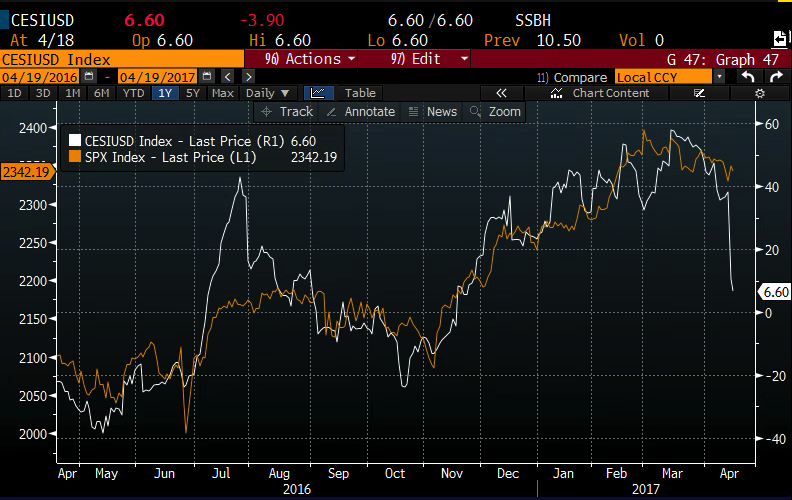So far, U.S. stocks could not be bothered in the least by dysfunction in Washington, increasing geopolitical tensions, the fissures in the European Union, or most importantly the recent weakening of economic data in the U.S.
To illustrate this point, the S&P 500 (SPX) is 2% from its all-time highs, but the Citi Economic Surprise Index for the U.S. (which has closely tracked the equity index over the last year) just plunged:

This morning’s Breakfast Briefing from the WSJ’s Ben Eisen offered some insight on the Citi Surprise Index’s importance to market participants:
The “soft” data on consumer and business sentiment that helped propel the index higher is now meeting with lackluster “hard” data on how the economy is actually doing. A Friday reading on the consumer price index, for example, came in sharply below expectations for March.
On Monday, data showed the National Association of Home Builders/Wells Fargo housing market index dropped to 68 this month from 71 in March, and below expectations of a 70 reading. And on Tuesday, data showed housing starts dropped 6.8% in March, again suggesting more caution from home-builders.
Take that together with other lackluster economic data, such as a weak March jobs report, and it’s becoming clear that the economy isn’t quite living up to the high hopes for it.
As Reuter’s Jamie McGeever explained it this am, Reflation trades of 2016 deflate with remarkable speed:
The “reflation” trades of 2016 that were supposed to mark a turning point in global markets are fading.
Fast.
….
The Federal Reserve raised interest rates twice, the dollar reached a 14-year peak, Wall Street hit record highs, and government bond yield curves around the world steepened to the benefit of banks and financial stocks.
But it is now unraveling, in large part due to a clear slowdown in U.S. growth and signs that global inflation is leveling off.
Flatter yield curves where short- and long-term bond yields are close to each other suggest economic uncertainty.
Certainty in financial markets is usually a dangerous thing. Before the election, there was near certainty that Clinton would win, and the status quo would be bad. There was also a near universal certainty that if Trump won, it would mean chaos for financial markets, largely because he brought a level of uncertainty to policy like we’ve never seen before. But in the wee hours of Nov 9th, big money playas went the other way, buying stocks that were locked down 5%, the dollar that was down 2% and made bullish bets on Treasury yields. That was the global (particularly U.S) reflation trade as financial powers that be, decided a supermajority in Washington meant pro-growth policies, and that would be good for risk assets.
Nearly 100 days into the presidency nothing significant has happened on the “pro-growth” agenda. GDP for Q1 is tracking well below the 2016 average (and importantly well below consensus), at just 50 basis points. The US Dollar Index (DXY) is down about 3.5% from its 14-year highs made in early January, the 10-year treasury yield is down 40 bps from 2.64% a month ago, with the differential between 10s and 3month treasuries at its lowest levels since the first week of October. Many economists view a quickly flattening yield curve as pre-cursor of a recession.
Which brings us back to stocks. The most economically sensitive group in the U.S are small caps, tracked by the Russell 2000 (RTY) which is the worst performing U.S. equity index, up only 35 basis points on the year. In the last 24 hours, three large Dow Jones Industrial Average components have seen their stock’s flail post earnings (Goldman Sach’s and Johnson & Johnson yesterday down 4.7% and 3.1% respectively and IBM down 5% as I write this morning). As far as large cap stocks, they are seemingly a crowded trade, per the WSJ yesterday, emphasis mine:
Technology-oriented companies dominate the list: Apple, the world’s largest company by market capitalization, is up more than 22% this year through Monday. Social-media company Facebook Inc. has risen nearly 23% while e-commerce powerhouse Amazon.com Inc. has climbed 20%.
Combined, shares of these three companies account for almost one-third of the S&P 500’s 2017 advance through this past Wednesday.
The recent strength in tech and internet companies marks a reversal from late last year, when investors piled into banks, industrials and small-cap stocks in the weeks following November’s U.S. elections.
With risk assets like Gold trading at the highest levels since the election, up 15% from its December post-uncertainty euphoria, mega-cap tech stocks have emerged as the safest of safe haven trades along with gold and treasuries in 2017. I am fairly certain this cannot last. Either the powers that be deliver on promises to stimulate growth, or wavering from the C-level suites may fan the flames of faltering growth. That would mean a retracement in risk assets that so far haven’t exhibited the least bit of apprehension among investors.